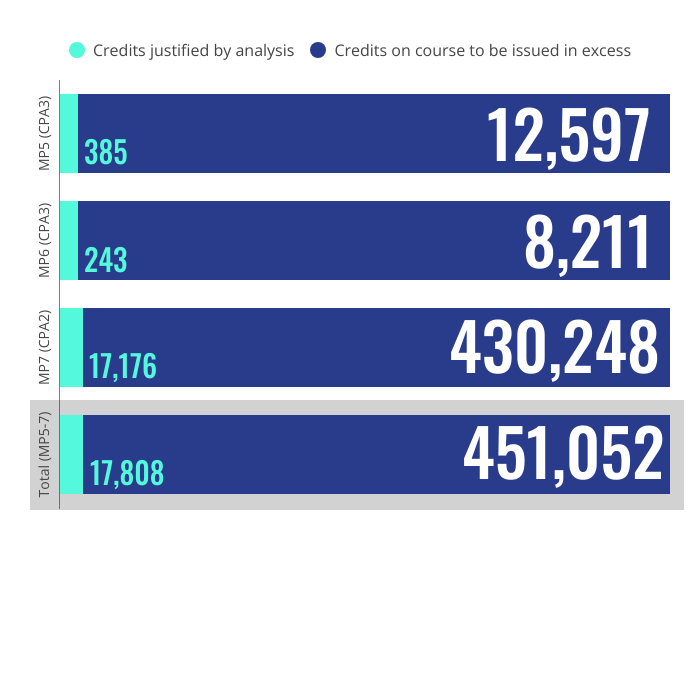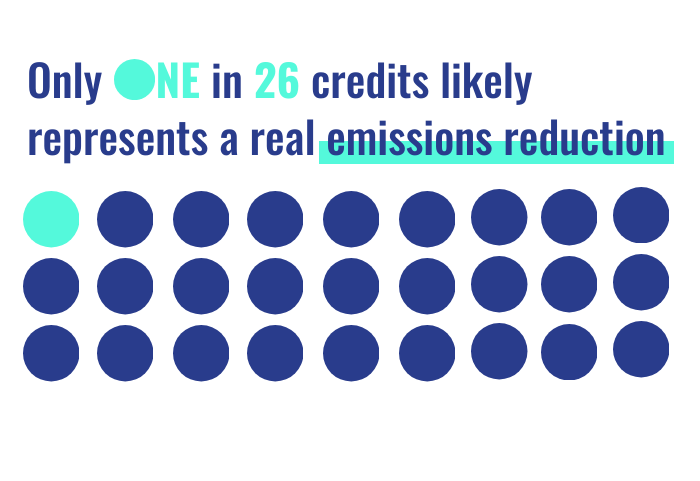For the initial batch of carbon credits set to be released under Article 6.4 of the Paris Agreement, only one in every 26 is likely to represent real emission reductions
As a result of international carbon market rules established under the Paris Agreement, thousands of legacy projects originating from the contentious UN-led carbon crediting scheme of the Kyoto Protocol era, the Clean Development Mechanism (CDM), are eligible to issue rebranded Paris Agreement-aligned credits.
The first example under the successor global carbon crediting mechanism introduced under Article 6.4 of the Paris Agreement, the Paris Agreement Crediting Mechanism (PACM), shows that it is already off to an inauspicious start.
A new Carbon Market Watch analysis, based on currently available project data, has uncovered that the first project transitioning from the CDM to the Article 6.4 market is potentially poised to issue an astonishing 26 times more credits than it should as compared to the values from peer-reviewed scientific literature.
Old wine in new bottles
This problem dates back to the problematic history of CDM credits, created under the Kyoto Protocol and remembered notably for their longstanding poor climate track record.
In 2012, the price of CDM credits plummeted as a result of major scandals and shortcomings. Time and again, civil society called for reigning in the CDM, as the credits generated lacked real climate benefits and some projects even infringed on human rights.
However, following the establishment of the Paris Agreement, governments have failed to take those warnings seriously and correct their mistakes of the past.
In the negotiations around the CDM phaseout, proponents managed to extend the life of CDM projects a little longer: those that wished to continue, could transition to the new PACM under certain conditions.
One condition was that after 2025, these projects would be required to relinquish the CDM crediting methodologies, which determine the volume of carbon credits that can be generated, and adopt the new Article 6.4 methodologies which are intended to be of higher quality.
In practice however, this deal meant that from 2021 though the end of 2025, project developers are able to misleadingly issue old CDM-quality credits with the new PACM-quality label. The problems however, remain the same: many CDM projects seeking to transition are of questionable environmental benefit, with some having even caused serious health problems that persist to this day.

A rocky start
We have investigated PoA 10415, a clean cookstove “Programmes of Activities” (a grouping of projects) in Myanmar. This is the first CDM project to have successfully jumped through all the transition hoops, and is in line to issue the first-ever carbon credits under Article 6.4 of the Paris Agreement.
Our analysis of project data for the first part of the crediting period, from 2021 to 2022, shows that the project plans to issue 26 times more credits than it should as compared to the values from peer-reviewed scientific literature (Find the results of our analysis here. Github data and code publicly accessible here). These findings are reinforced by carbon credit rating agency Calyx Global, which found earlier that this Article 6 project has “significant risks to greenhouse gas (GHG) integrity”.
Clean cookstove projects like this one generate carbon credits by replacing traditional cooking methods such as burning firewood in households with more efficient and lower-emission cookstoves. These project types can lead to important social and health improvements (e.g. reduced indoor air pollution), but can often be unreliable in estimating the emissions mitigated.
Emission reductions from the installation of improved cookstoves are calculated through CDM methodology AMS-II.G, like the project we assessed above. A 2024 peer-reviewed study found that of all cookstove project methodologies it is associated with the highest levels of over-crediting, in other words, issuing many credits without a verifiable climate impact.
Troublingly, this first project may only be the start. As of March of this year, 1,389 projects as well as 119 programmes of activities of the CDM (“programmes of activities” are aggregated projects, consisting here of 954 smaller projects) have filed the documents necessary to transition into the Article 6.4 system. To get an idea of the scale of this issue: nearly 1 billion repackaged CDM credits with questionable credentials could flood the nascent Article 6 market.
In an upcoming research piece, CMW finds that 19 other cookstove projects with questionable quantification methods currently await approval to transition into the Article 6.4 mechanism. This raises concerns over the credibility of the market, especially in light of current debates on the inclusion of international credits into compliance systems worldwide (South Korea, EU).
Negotiators at COP29 in Baku highlighted concern with this situation making a last ditch attempt to throw up a firewall against the old Kyoto Protocol projects waiting at the PACM gates. A paragraph was introduced that requested the additionality of CDM transition projects to be assessed, but was not included in the final version of the text. As a result, the CDM transition is now in full swing, without any quality controls in place.

Damage control
For these initial Article 6.4 credits to be of such low quality is highly concerning and is incompatible with the core principles of the Paris Agreement commitments. There is still an opportunity to limit the damage, but urgent action is needed now.
Carbon Market Watch calls on all countries where old CDM projects are in the process of applying to become recognised under Article 6 of the Paris Agreement to hold off on approving them until they are verified by an independent quality assessment, based on the latest science, and the underlying crediting methodologies are revised.
Not only would permitting these projects harm the worldwide fight against climate change and undermine the credibility of the Article 6.4 market, it will also hurt the chances of host countries being able to meet their own climate targets as emissions balance sheets must be adjusted to account for exaggerated mitigation.
In addition to this, while it’s too late to halt the CDM transition, the Article 6.4 Supervisory Body – the UN entity responsible for overseeing the rules for this carbon market – should take urgent action to ensure that from 2026 onwards, transitioning projects are fully Paris-aligned.
This means revising the relevant methodologies, and if need be, declaring methodologies incompatible with crediting under the Article 6.4 market. Given the well-documented and persistent problems with the CDM, we can ill-afford to repeat the same mistakes under Article 6.4. Otherwise, the Paris Agreement Crediting Mechanism under Article 6.4 will not become a benchmark, but a continuation of a toxic legacy that is disastrous for the climate.
In the absence of such measures to prevent the emergence of damaging Article 6.4 credits, governments must refrain from using them to meet their own climate targets. This is particularly relevant for the European Union, where lawmakers are considering relying on Article 6 credits to meet the EU’s 2040 climate target.
Buyers beware!
____________
Note: This article was updated on 5 May 2025 to slightly adjust the overestimatation factor from 27.4 to 26.
Authors
-

-

Benja Faecks works on global carbon markets, with a focus on the voluntary carbon market.
View all posts







